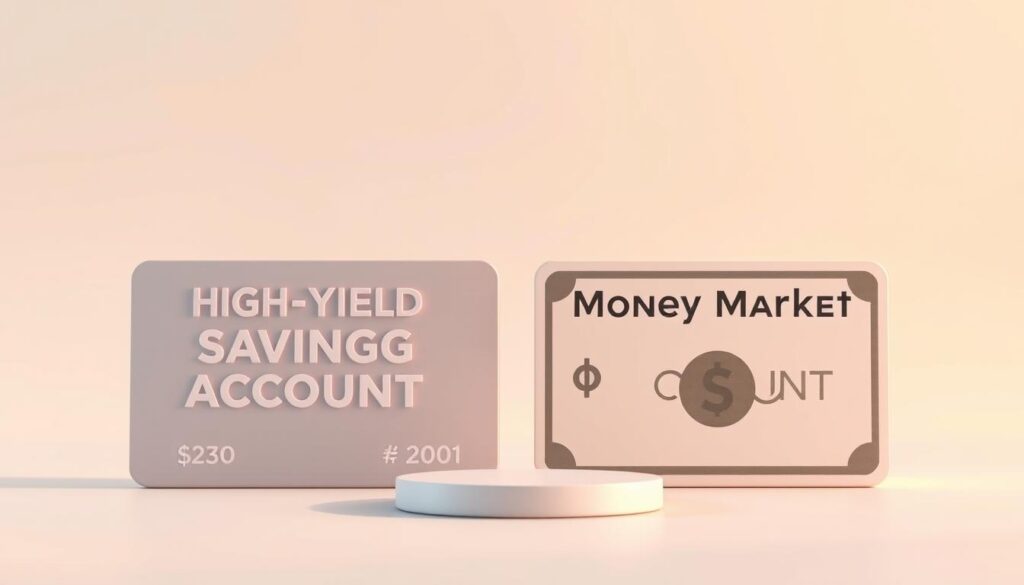If you’re looking to grow your money faster, the current financial landscape offers strong opportunities. Many financial institutions now provide high-yield savings accounts with rates that far outpace traditional options. While the national average remains low, select banks offer annual percentage yields (APY) above 4%, making it easier to maximize your earnings.
The Federal Reserve’s recent rate adjustments have influenced these trends. With steady rates in 2024 and gradual cuts this year, competitive interest rates are still available. Some institutions, like Axos Bank and BrioDirect, currently lead the market with APYs nearing 5%. Plus, all recommended options come with FDIC insurance, keeping your deposits secure.
Key Takeaways
- Many banks now offer significantly higher returns compared to standard savings options.
- Recent Federal Reserve policies continue to impact available yields.
- Top-performing accounts provide APYs above 4%, with some nearing 5%.
- FDIC insurance ensures your funds remain protected.
- Comparing rates helps you find the best fit for your financial goals.
What Are High-Yield Savings Accounts?
Not all savings options are created equal—some offer significantly higher growth potential. A high-yield savings account is a federally insured bank account that earns interest at rates much higher than the national average (currently 0.41%). Many now pay over 4% annual percentage yield (APY), helping your money grow faster.
- Compound interest: Earnings are calculated daily and added monthly, accelerating growth over time.
- FDIC/NCUA protection: Deposits up to $250,000 per account are insured against bank failures.
- Online vs. traditional banks: Digital banks often offer better rates due to lower overhead costs.
Despite myths, these accounts don’t lock your money away. Federal rules limit withdrawals to six per month, but there are no penalties for exceeding this—just potential account conversion or closure.
Approval typically involves ChexSystems verification, a screening tool banks use to review your banking history. If you’ve had past issues like overdrafts, check your report beforehand.
Best High-Yield Savings Accounts in 2025 (5.5%+ APY)
Finding a competitive rate can make a big difference in your earnings. Below, we’ve highlighted three standout options that combine strong yields with user-friendly features.
Axos Bank: No Minimum, High Returns
Axos Bank leads with a 4.66% APY and no minimum deposit, making it ideal for beginners. Mobile check deposits and 24/7 account access add convenience.
BrioDirect: Premium Rates, Higher Threshold
BrioDirect offers a 4.50% APY but requires a $5,000 minimum deposit. Its flexible external transfers appeal to savers with larger balances.
Bread Savings: Low Barrier, No Fees
With a 4.40% APY and just $100 to start, Bread Savings stands out for its lack of monthly fees. It also provides CD options for long-term growth.
«Small differences in rates add up over time—always compare terms.»
- Mobile apps matter: Bask Bank (4.9/5) edges out EverBank (4.7/5) in user ratings.
- Niche perks: Fitness Bank rewards active users with 4.55% APY.
Key Features to Compare
Understanding account features helps you pick the right option for your needs. Look beyond the interest rate—details like deposit rules, fees, and access restrictions matter just as much.
Minimum Deposit Requirements
Some banks let you start with $0, while others set high bars. For example:
- Pibank: No minimum deposit required.
- TotalBank: Demands $25,000 to open an account.
- SoFi: Offers top rates only with a $5,000 balance.
Choose based on your budget. A low or no minimum deposit works best if you’re starting small.
Monthly Fees and Waivers
Hidden costs can eat into your earnings. Compare these structures:
- Bread Savings: No monthly maintenance fees.
- Rising Bank: Charges a $1,000 penalty for early closure.
- Many institutions: Add $5 fees for paper statements.
«Always check the fine print—what looks free might have strings attached.»
Withdrawal Limits and Penalties
Federal rules cap withdrawals at six per month. Banks handle violations differently:
- Zynlo: Allows mobile deposits only.
- Vio Bank: Offers ATM access but may charge $25 for excess transactions.
If you need frequent access, prioritize accounts with flexible withdrawal limits.
How to Choose the Right Account for You
Your banking needs should guide your choice of a savings solution. As NerdWallet expert Margarette Burnette advises, «Consider overall banking needs—mobile access and support matter as much as rates.» Start by matching the account type to your goals.

An emergency fund works best with easy withdrawals, while a house downpayment benefits from higher interest rates. Compare digital features too. EverBank’s performance tracking helps visualize growth, while Ally’s «buckets» organize savings goals.
Regional limits can surprise you. Openbank, for example, excludes Northeast states. Prioritize 24/7 support if you need flexibility—TAB Bank outperforms weekend-only services.
- Eco-friendly options: Forbright Bank donates a portion of profits to sustainability projects.
- Mobile ratings: Apps with 4.5+ stars (like Ally) reduce friction for daily use.
- Deposit rules: Some bank accounts reject cash deposits—check before signing up.
«Small details—like ATM reimbursements or Zelle integration—can tip the scales for busy savers.»
Finally, review fee structures. A 4.5% APY loses value if monthly charges eat into earnings. Choose wisely—your future self will thank you.
Benefits of High-Yield Savings Accounts
Growing your money doesn’t have to be complicated—some accounts do the heavy lifting for you. With better rates and built-in security, these options help your funds grow faster while keeping them accessible.
Higher Interest Earnings
A 4% rate on $10,000 earns $400 annually—10x more than traditional accounts. Compound interest boosts this further. Here’s how balances grow over time:
| Initial Deposit | 1 Year | 3 Years | 5 Years |
|---|---|---|---|
| $10,000 | $10,400 | $11,249 | $12,167 |
| $25,000 | $26,000 | $28,122 | $30,417 |
«Time is your best ally. Even small rate differences compound into significant gains.»
FDIC Insurance Protection
Your deposits stay safe with FDIC insurance (or NCUA for credit unions). Key protections include:
- Up to $250,000 per account at insured banks.
- Biometric logins at institutions like Openbank for added security.
- No lock-in periods, unlike CDs—withdraw anytime.
Automated tools make saving effortless. Platforms like Ally round up purchases or schedule transfers, helping you grow balances passively.
Potential Drawbacks to Consider
Higher interest rates often come with specific conditions you should know. While these accounts help grow your money faster, some restrictions might affect how you manage your funds.
Minimum balance requirements vary widely. SoFi demands $5,000 to unlock its top rate, while Primis Bank offers 4.35% APY with just $1. If your balance dips below the threshold, you could earn less or face fees.
Accessing cash isn’t always easy. Over 70% of top accounts lack ATM cards, and mobile deposits may cap at $10,000 per day (like My Banking Direct). Federal rules also limit withdrawals to six per month.
Rates aren’t locked in. After Fed adjustments, your interest rate could drop. BrioDirect even closes inactive accounts after 21 days. Check for monthly fees too—some charge for paper statements or low balances.
«Always read the fine print—what looks flexible might have hidden limits.»
Past banking issues could block approval. Banks use ChexSystems to review overdrafts or unpaid fees. If you’ve had problems, check your report first.
High-Yield Savings vs. Traditional Savings Accounts
When deciding where to park your cash, the difference between account types can impact your earnings significantly. While traditional savings accounts from banks like Chase or Wells Fargo average just 0.10% APY, top-tier alternatives now offer over 4.25%.
Brick-and-mortar locations provide in-person service, but online bank options typically deliver higher interest rates. Digital institutions save on overhead costs, passing those savings to customers through competitive yields.
Fee structures also diverge. Many traditional savings accounts charge $5 monthly fees unless you maintain high balances. Over 90% of high-yield options waive these entirely.
«Convenience has a price—sometimes it’s paid in lost interest earnings.»
Accessibility varies too. While both account types are FDIC-insured, traditional accounts often include ATM cards and branch access. High-yield alternatives may limit withdrawals or require mobile deposits.
Mobile features reveal another gap. Most legacy bank apps lack tools like round-up savings or goal tracking, which are standard in digital-first platforms.
Ultimately, your choice hinges on priorities. Prefer face-to-face service? A traditional savings account might suit you. Prioritize growth? The higher APY of modern accounts could be worth the trade-offs.
High-Yield Savings vs. Money Market Accounts
Money market accounts and yield savings options serve distinct financial needs. While both help grow your funds, their features cater to different priorities—immediate access versus higher returns.

Accessibility Differences
Money market accounts (MMAs) often include debit cards and check-writing, unlike most yield savings accounts. For example, CIT Bank’s MMA allows unlimited ATM withdrawals, while its yield savings option requires transfers that take 1–3 days.
Check deposits are another key distinction. Nearly 80% of MMAs accept them, whereas yield savings accounts typically rely on mobile or direct deposits.
Interest Rate Comparisons
MMAs usually offer slightly lower interest rates. Here’s how top options stack up:
| Account Type | Institution | Rate (APY) | Minimum Balance |
|---|---|---|---|
| MMA | CIT Bank | 4.30% | $100 |
| Yield Savings | CIT Bank | 4.60% | $0 |
| MMA | TotalBank | 4.15% | $25,000 |
«Choose based on usage. If you need frequent access, MMAs win. For pure growth, yield savings pull ahead.»
- Transaction limits: MMAs allow unlimited ATM withdrawals; yield savings cap at six monthly transfers.
- Balance requirements: Some MMAs, like TotalBank’s, demand high minimums ($25k) for top rates.
- Hybrid perks: A few MMAs (e.g., Schwab) combine checking account features with competitive yields.
High-Yield Savings vs. Certificates of Deposit (CDs)
Flexibility versus fixed terms—understanding this choice matters. While 12-month certificates of deposit currently average 5.00% APY versus 4.75% for top savings options, liquidity needs often determine the better fit.
Need instant access? Savings accounts win. Most CDs charge 3-6 months of interest for early withdrawals. For emergency funds, that penalty could erase years of gains.
When the Fed cuts rates, locked-in CD interest rates protect your earnings. This makes CDs ideal for stable, mid-term goals like car purchases.
| Strategy | CD Approach | Savings Alternative |
|---|---|---|
| Laddering | Open multiple CDs with staggered terms | Use separate savings buckets |
| Rate Changes | Lock rates for each CD term | Earnings fluctuate with market |
| Access | Wait for maturity dates | Withdraw anytime |
«CDs reward patience—if you won’t need the money, their higher APY compounds reliably.»
Jumbo CDs ($100k+) sometimes offer better interest rates, but standard savings accounts have no upper balance limits. For most savers, mixing both tools optimizes growth and accessibility.
Remember: Savings accounts shine for fluid needs, while certificates of deposit excel for predictable, longer-term goals. Your timeline should guide the choice.
How Much Can You Earn with a High-Yield Savings Account?
Understanding potential earnings helps you make smarter decisions about where to save. The right account can significantly boost your interest earnings over time, turning small percentages into meaningful growth.
Breaking Down the Numbers
Let’s examine a $10,000 deposit at 4% APY. Without additional contributions, you’d earn interest totaling $400 in the first year. Add $100 monthly, and your balance grows to $2,273 after 12 months.
Compound interest accelerates growth. Your earnings generate more earnings, creating a snowball effect. Online calculators show how balances develop across different timeframes:
- 5 years: $12,167 (no additions)
- 10 years: $14,802 (no additions)
- 5 years: $18,494 ($100/month)
Tax Considerations
The IRS treats interest as taxable income. You’ll report earnings over $10 on Form 1099-INT. Some states tax this income too—check local regulations.
«Always factor taxes into your projections. A 4% return might net closer to 3% after taxes.»
Comparing Investment Options
While the S&P 500 averages 7% returns, savings accounts offer stability. Market investments carry risk—your principal isn’t guaranteed like FDIC-insured deposits.
Inflation affects purchasing power. At 3% inflation, a 4% APY yields just 1% real growth. Consider this when setting long-term goals.
Contribution Strategies
Regular deposits dramatically impact results. Compare these scenarios for a 4% account:
| Approach | 5-Year Total |
|---|---|
| $10,000 lump sum | $12,167 |
| $500 monthly | $33,243 |
Small, consistent contributions often outperform large one-time deposits. Automate transfers to build wealth effortlessly.
Historical Trends in Savings Account Rates
Savings account interest rates have shifted dramatically over the past decade. The national average hovered near zero for years before recent Fed actions sparked meaningful growth. Understanding these patterns helps you spot opportunities in today’s market.
Ally Bank’s journey reflects broader trends. Their APY climbed from 3.60% in 2023 to 4.35% this year. Meanwhile, the national average rose from 0.33% to 0.41%—still lagging behind top performers.
Key Rate Drivers
Three factors shaped today’s landscape:
- Fed rate hikes: Seven increases since 2022 pushed yields upward
- Digital competition: Online banks consistently outpaced traditional institutions
- Economic recovery: Post-COVID demand for deposits intensified rate wars
Regional banks joined the fray too. Some offered limited-time bonuses up to 5.25% APY to attract customers. These promotions often came with strict balance requirements.
| Year | National Average | Top Online Rate |
|---|---|---|
| 2020 | 0.09% | 1.50% |
| 2022 | 0.17% | 3.30% |
| 2025 | 0.41% | 4.75% |
«Rate cycles follow economic trends—we’re now seeing the payoff from years of Fed tightening.»
Experts predict modest declines in 2026 as inflation stabilizes. However, digital-first banks will likely maintain interest rates 8-10x higher than the national average.
Your takeaway? While past performance doesn’t guarantee future results, these savings accounts currently offer rare value. Locking in today’s APY could benefit you for years.
How to Open a High-Yield Savings Account
Getting started with a high-earning account is simpler than you might think. Most banks offer streamlined online applications, letting you open account options in minutes. Whether you’re saving for emergencies or a future goal, the right bank account can maximize your returns.

Required Documentation
You’ll need basic details to verify your identity. Prepare these before applying:
- Social Security Number (SSN): Used for tax reporting and fraud prevention.
- Government-issued ID: Driver’s license, passport, or state ID.
- Proof of address: Utility bill or lease agreement (if your ID lacks current info).
Some banks check your ChexSystems report—a record of past banking activity. Negative marks (like unpaid fees) could delay approval.
Funding Your Account
Initial deposit requirements vary. While Bask Bank lets you start with $0, others ask for $100–$5,000. Choose a funding method that fits your timeline:
| Method | Speed | Best For |
|---|---|---|
| ACH Transfer | 1–3 business days | Low-fee, routine deposits |
| Wire Transfer | Same day | Urgent or large transfers |
| Mobile Check Deposit | 1–2 days to clear | Paper checks (limits may apply) |
«Digital onboarding cuts setup time—Bask’s 10-minute process beats traditional banks’ paperwork.»
Joint accounts require extra steps. Both owners must provide IDs and agree to terms. Funds typically become available within 1–2 business days after approval.
What to Do If Your Application Is Denied
A denied application doesn’t mean the end of your savings journey—options exist to get back on track. Most rejections tie to ChexSystems, a reporting agency banks use to review your *banking history*. Overdrafts, unpaid fees, or errors here can block approvals.
Steps to Resolve ChexSystems Issues
Dispute errors first. By law, you can request a free ChexSystems report annually. If you spot mistakes, file a dispute online or by mail. Banks must correct inaccuracies within 30 days.
Second-chance accounts bypass traditional checks. Institutions like Chime or Varo don’t use ChexSystems, making them ideal for rebuilding access. These often have:
- No monthly fees
- Mobile deposit features
- Lower minimum balances
| Bank | Account Type | Key Benefit |
|---|---|---|
| Chime | Spending Account | No ChexSystems check |
| Varo | Cash+ Savings | Early direct deposit |
| LendingClub | Essential Checking | 1% cashback on debit |
«Negative marks fade after five years. Use secured accounts to demonstrate reliability meanwhile.»
Rebuilding Your Banking History
Secured accounts help. These require a refundable deposit (e.g., $200) as collateral. Over time, responsible use can qualify you for standard accounts.
Some banks accept *explanation letters* for past issues. Detail steps you’ve taken to avoid repeats, like setting up low-balance alerts.
If all else fails, credit unions often have softer policies. Local institutions may overlook minor blemishes if you join their membership network.
Safety and Security of High-Yield Savings Accounts
Your money’s security matters just as much as its growth potential. Modern financial institutions combine robust protections with competitive returns, giving you peace of mind while your balance grows.
Every recommended bank carries FDIC insurance or NCUA coverage. This government-backed protection safeguards up to $250,000 per depositor against institutional failures. Your funds remain accessible even if the bank faces financial challenges.
Digital security measures have evolved dramatically. Today’s top savings account providers implement:
- 256-bit encryption – The same standard used by military organizations
- Biometric logins – 78% of leading banks now offer fingerprint or facial recognition
- Behavioral monitoring – Systems flag unusual activity patterns instantly
- Device authentication – New logins require secondary verification
Fraud prevention goes beyond passwords. Many institutions employ:
- Real-time transaction screening
- Micro-deposit verification for external links
- Automatic session timeouts
«Security isn’t just about technology—it’s about constant vigilance. Our systems undergo 200+ annual penetration tests.»
Regular audits ensure compliance with federal regulations. Look for FDIC insurance logos and SOC 2 Type II certifications when choosing your savings account. These indicate rigorous third-party testing of security controls.
With these protections, you can focus on growing your money rather than worrying about its safety. The right account keeps your funds secure while earning competitive returns.
Tax Implications of Interest Earnings
Your interest income isn’t just free money—the IRS wants its share too. Banks report all interest earnings over $10 using Form 1099-INT. You’ll include this with your tax return, even if no physical form arrives.
How much you owe depends on your tax bracket. Here’s how $1,000 in interest earnings plays out:
| Tax Bracket | Federal Tax Owed | Net Earnings |
|---|---|---|
| 10% | $100 | $900 |
| 22% | $220 | $780 |
| 32% | $320 | $680 |
State rules add another layer. Some states fully tax interest earnings, while others offer breaks:
- Texas/Florida: No state income tax
- California: 1-13.3% tax rate
- New York: 4-10.9% plus local taxes
«Retirement accounts like IRAs defer taxes on growth—a smart alternative for long-term savings.»
The IRS treats interest differently than dividends. While qualified dividends get lower capital gains rates, interest earnings always count as ordinary income.
Watch for deductible fees too. Some banks charge annual account fees—these may qualify as miscellaneous deductions if you itemize.
Planning for these tax implications ensures you keep more of your hard-earned growth. A little preparation goes a long way.
Conclusion
Smart savers know that small rate differences create big gains over time. For flexibility, Bread Savings shines with no fees and a low minimum. Larger balances thrive with BrioDirect, while Axos Bank delivers pure yield potential.
Rates may dip slightly in 2025, but top accounts will still outperform traditional options. Keep 3–6 months’ expenses in an accessible savings account for emergencies. Review rates quarterly—banks often adjust APY with market shifts.
Diversify across accounts to balance access and growth. For most, Axos offers the best blend of high returns and ease. Start today—your future self will thank you.
FAQ
What makes these accounts different from regular ones?
They offer much higher interest rates, often 10-12 times the national average, helping your money grow faster while keeping it accessible.
Is my money safe in these accounts?
Yes! Funds are FDIC-insured up to 0,000 per depositor, just like traditional bank accounts, so your cash stays protected.
Do I need a large amount to open one?
Not always. While some require 0-,000, many let you start with just



